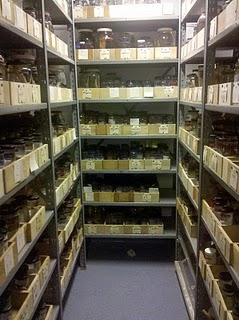...here's something distinctly more marine.
 A little while ago I drew attention to Andrea Marshall's paper showing that there's not one but possibly three species of manta ray (see Whats A Manta Do?). In the preamble for that post, I drew analogy between mantas and killer whales as monotypic species; that is, the only members of their genus, a taxonomic one-of-a-kind. Well blow me down if some new genomics work with killer whales doesn't suggest that there's more than one species of those, too! Morin and colleagues used a different approach than Marshall, whose work was mostly based on colors and patterns and tooth shape. Instead, they used "massively parallel pyrosequencing" (try saying that with a mouth full of marbles) to show genetic differences in the mitochondrial genome. So what the heck does that mean? Well, lets just say its sequencing a whole bunch of DNA at once, using DNA not from the nucleus of the cell, but from its engine room: the mitochondrion. The technology is actually a really, fantastic example of miniaturisation; perhaps I'll write about it one day. But, I digress... Morin and friends recommend three species of Orcinus orca, with two more subspecies as well. Subspecies are not required by the taxonomic code, but they are eligible for separate protections under the Endangered Species Act, so its a meaningful result for conservation biologists too; they'll now have to make assessments of each species and subspecies to see which, if any, require additional protections.
A little while ago I drew attention to Andrea Marshall's paper showing that there's not one but possibly three species of manta ray (see Whats A Manta Do?). In the preamble for that post, I drew analogy between mantas and killer whales as monotypic species; that is, the only members of their genus, a taxonomic one-of-a-kind. Well blow me down if some new genomics work with killer whales doesn't suggest that there's more than one species of those, too! Morin and colleagues used a different approach than Marshall, whose work was mostly based on colors and patterns and tooth shape. Instead, they used "massively parallel pyrosequencing" (try saying that with a mouth full of marbles) to show genetic differences in the mitochondrial genome. So what the heck does that mean? Well, lets just say its sequencing a whole bunch of DNA at once, using DNA not from the nucleus of the cell, but from its engine room: the mitochondrion. The technology is actually a really, fantastic example of miniaturisation; perhaps I'll write about it one day. But, I digress... Morin and friends recommend three species of Orcinus orca, with two more subspecies as well. Subspecies are not required by the taxonomic code, but they are eligible for separate protections under the Endangered Species Act, so its a meaningful result for conservation biologists too; they'll now have to make assessments of each species and subspecies to see which, if any, require additional protections.
To the experts, its not a total surprise that there are multiple species in either of these groups. You can bet your bum that they set out to confirm a hunch that there are more than one, leaving the surprise for the rest of us less familiar with these beasties and who never saw the subtle differences. That's OK, I like surprises, especially when they involve new and unexplored diversity, right under our noses. Maybe we should take a harder look at a few more monotypics, for the inevitable species flocks hiding in the details or the DNA. Whale sharks, basking sharks, Mola, anyone?
Morin, P., Archer, F., Foote, A., Vilstrup, J., Allen, E., Wade, P., Durban, J., Parsons, K., Pitman, R., Li, L., Bouffard, P., Abel Nielsen, S., Rasmussen, M., Willerslev, E., Gilbert, M., & Harkins, T. (2010). Complete mitochondrial genome phylogeographic analysis of killer whales (Orcinus orca) indicates multiple species Genome Research DOI: 10.1101/gr.102954.109
 Tuesday, April 27, 2010 at 11:00AM
Tuesday, April 27, 2010 at 11:00AM 














